
Update: Read our hands on Samsung Galaxy S8 review, check our deals page for best S8 pre-order offers and see how the Galaxy S8 shapes up against the LG G6 in our in-depth versus.
The Samsung Galaxy S8 has finally been launched and… well, it's entirely as we expected thanks to the myriad leaks that sprung up all over the internet in the preceding months.
But the good news is that it's a rather nifty phone, and you can check it out in some rather sumptuous depth in our hands-on: Samsung Galaxy S8 review to get all the morsels of information you could want on Samsung's new flagship.
We know that some of you are in more of a rush though, and just want to know what's new and whether you should care about the new Samsung phone – and no, before you ask (and we have been asked countless times): it's not going to catch fire this time. Samsung has been very clear about that.
What it will do is impress you with the large display, faster innards and all-round improvements throughout the user interface – so if you're not going to check out our thorough and filled-with-beautiful-photos Samsung Galaxy S8 hands-on (the plugs will only get more shameless) we've rounded up all the salient information here.
- Fancy something bigger? You'll want the Samsung Galaxy S8 Plus
Samsung Galaxy S8 release date
SAMSUMG GALAXY S8 SPECS
Want to know the specs? We've got them all here:
Dimensions: 148.9 x 68 x 8mm
Screen size: 5.8 inches
Resolution: 1440 x 2960 (QHD+)
Processor: Exynos 8895
RAM: 4GB
Storage: 64GB
Rear camera: 12MP
Front camera: 8MP
Battery: 3,000mAh
- Rear fingerprint scanner
- Water- and dust-resistant (IP68)
- No physical home button
- Iris scanner
- Bixby AI assistant
- Headphone jack
Screen size: 5.8 inches
Resolution: 1440 x 2960 (QHD+)
Processor: Exynos 8895
RAM: 4GB
Storage: 64GB
Rear camera: 12MP
Front camera: 8MP
Battery: 3,000mAh
- Rear fingerprint scanner
- Water- and dust-resistant (IP68)
- No physical home button
- Iris scanner
- Bixby AI assistant
- Headphone jack
- Galaxy S8 release date US: April 21
- Galaxy S8 release date UK: April 28
Samsung has now confirmed the Galaxy S8 release date: April 21 for the US, and April 28 for the rest of the world (including the UK) - although it hasn't given specific information on territories such as Australia.
You can pre-order the phone already and if you do so before April 19 you'll get the Samsung Galaxy S8 delivered to your door as soon as the April 20 if you're in the UK (but no word on a free Gear VR... boo).
Samsung Galaxy S8 price
- Galaxy S8 price: $720, £689, AU$1,199
The SIM-free Samsung Galaxy S8 price is $720 (£689, AU$1,199) - which certainly makes it one of the most expensive phones on the market.
On contract in the US, it'll cost you anywhere from $28 to $35 a month, depending on your carrier.
In the UK you'll be able to pick up the Galaxy S8 for around £40 per month on a two year deal - put you'll have to part with some cash upfront too.
However, for that money you do get more storage than before, as the phone will land with 64GB of on board storage, rather than the 32GB of last year – plus there's a microSD card slot and some decent AKG headphones in the bundle too.
- Samsung Galaxy S8 price: how much does it cost?
- You can find the best Samsung Galaxy S8 deals here
Key new features
- Rear-mounted fingerprint sensor
- Bixby AI assistant with dedicated button
- Massive Infinity Display on the front
- Refined user interface
If you're reading this section, you're wondering one thing: what's actually new about the Samsung Galaxy S8, and should you really care?
Well, in our eyes there are three major upgrades that Samsung fans will be most drawn to, beyond the impressive upgrades to power and performance throughout the phone.
The first is the new Infinity Display that adorns the front of the Galaxy S8, a massive 5.8-inch screen that wraps its way around most of the phone.
Yes, that's right: it wraps, as this is a curved screen by default. There's no flat version this year as Samsung saw how well-received the Galaxy S7 Edge was last year and decided to make that the flagship experience.
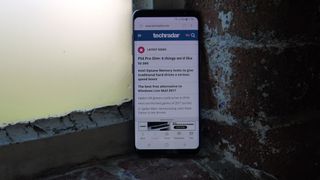
It's a QHD resolution, but longer – just like the LG G6, the screen is in the longer 18.5:9 aspect ratio - which means some apps will initially display with bars left and right.
The screen on the S8 is also HDR-enabled, so if you're paying extra on Netflix (or just using Amazon Prime Video) you'll be able to get the superbly bright and colorful experience on your mobile.
The second big change is the addition of another key on the phone, which will take you to the Bixby assistant. This is Samsung's big play in the smartphone AI stakes, a contextual assistant that can work out what you need through voice, touch or the camera.
- Find out more about Samsung's Bixby AI assistant
We'll be honest: it's not that impressive yet. You can only get it in the US or South Korea at launch, and it can only do a very limited number of things – essentially this is Siri, but a few years back when it comes to voice.
Advertisement
However, Bixby Vision in the camera can do more, working out places and products that it's seeing, as well as matching certain items on Pinterest.
The big play from Samsung here is that it, eventually, wants Bixby to take on Alexa by being the AI that's coded into every app.
However, right now it's not even in all the default Samsung apps – only the camera and phone systems at the moment, with more rolling out in the future as well as a toolkit for third-party developers.
In short: Bixby currently isn't as good as Google Assistant, which is thankfully also on the phone.
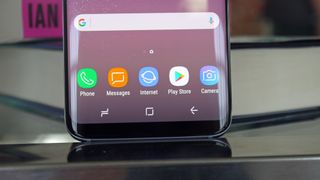
The final big change is to the UI – and some people still won't be happy, while others will. The reason for this divide of opinion is that the Samsung Galaxy series TouchWiz overlay, which sits atop Android, has been maligned for years as too overbearing.
Well, for years Samsung has been refining the experience, making it lighter to use and look at, and this year it's cleaner than ever without losing the Samsung 'look' that many of its users will be accustomed to.
This means the fonts are smoother, the menus more clean and natural-looking (with little recommendations of other things you might be looking for in the settings menu – a nice touch), and even the symbols for navigating through the phone have been altered to offer a more premium look.
(Well, we say premium – they look more like ancient runes or hieroglyphics. But hey, that's what's there).
- Samsung Galaxy S8 colors: what options will you have?
Right, that's the big changes out of the way – so let's get on to how this thing looks. The design is covered in more depth through our Samsung Galaxy S8 hands-on (we told you there would be more plugs) but here are the main points:
The screen covers most of the front of the phone, but we didn't experience any accidental taps of the display simply by holding the Galaxy S8 – there are obviously some smarts coded into the handset to stop that happening.
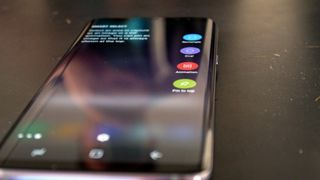
The home button is gone now – there's nothing visible on the front of the phone any more. There is a pressure-sensitive button at the bottom of the phone, in a similar vein to that on the iPhone 7, where you can press where the home key WOULD have been and you'll get a pleasant buzz.
The fingerprint scanner is now on the back of the phone, next to the camera, and it's a bit too high up for our liking, meaning we're more inclined to use the facial recognition or even the iris scanner to open the phone.
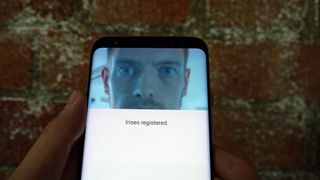
The outer rim is a fusion of metal and glass, with everything rolling attractively together in the hand, and very few hard edges to find under the finger.
In short, it's a very well made phone from Samsung, and with the headphone jack still present and correct, it's going to please a fair few users looking to get a top-end phone with beautiful lines.
Camera
- Single, 12MP rear facing camera
- 8MP front facing camera

The Samsung Galaxy S8 camera hasn't really been given much of an upgrade compared to the Galaxy S7, which will be a bit of a disappointment for some. The Galaxy S6 had a good snapper and yet Samsung still decided to upgrade it – but no such luck this year.
Well, if we're being fair there might be some internal tweaks that mean you're getting a better picture thanks to improved software – we'll need to test to be sure, but in our initial look (which you can read here) we didn't see too much different.
However, the 12MP sensor on the back is still one of the best around, offering speedy snaps and great performance in low light. This year Samsung has added in something called multi-frame image, which takes three snaps and finds the sharpest, so the quality should be improved in terms of what you're looking at, at least.

There's also the same impressive range of modes and options from Samsung within the Galaxy S8, from the clever auto mode, which manages to pick out a great picture nearly every time, to the professional mode, which offers the chance to really tweak the settings and shoot in raw too.
The front-facing camera has been boosted to 8MP, and there's also a fun new effects button which you can use to give yourself a range of augmented reality makeovers to entertain your friends, as they wonder why you've not just decided to use Snapchat instead.
Battery
- 3,000mAh, non-removable power pack
- Fast and wireless charging support
Samsung hasn't really done much to the battery either with the Galaxy S8, which does raise our eyebrows a touch.
The new chipset inside has been improved to offer 10% more CPU power and 21% better management on the GPU, so everything should fly along faster and with more efficiency.
However, there's only a 3000mAh battery in the Samsung Galaxy S8, which is the same as last year – and with more pixels to power on the front of the phone (thanks to the longer aspect ratio and display) that's something to think about.
It could explain why Samsung has limited the screen resolution on the Galaxy S8 to Full HD by default, with users needing to delve into the settings and boost the sharpness manually.

That said, the Galaxy S7 Edge was one of the best phones we had on test for battery life last year, so there's every chance Samsung has done more than enough to deliver a phone that can last well over a day.
On top of that there's also a full suite of wireless charging compatibility – in short, if there's a wireless charging point where you are, it can charge your Galaxy S8.
Fast charging is also enabled, although Samsung hasn't given exact numbers on how quickly the handset will power up just yet.
We'd estimate about 15 minutes of charge giving you a third of your power back, but we'll await confirmation from Samsung on that one.
Power and operating system
- 4GB of RAM
- Android 7 with TouchWiz interface
- Use two sets of wireless headphones at the same time
It looks like Samsung has split its processor strategy with the Galaxy S8, with the Qualcomm Snapdragon 835 likely at the heart of the phone in the US, with the Exynos 8895 doing the grunt work throughout the rest of the world.
Thing is, Samsung hasn't explicitly said this is case. We know some Galaxy S8 will definitely pack the Exynos 8895 chip though, as the firm has tweeted confirmation of this.
There's 4GB of RAM in the Galaxy S8 too. Rumor has it that Asian markets will be getting more (and Samsung has cryptically said the specs will vary throughout the world); however, 4GB is more than enough, and in our tests (you can read about them in our in-depth hands-on Samsung Galaxy S8 review... you know you want to) we found the phone to be lightning fast.
As mentioned, the Samsung Galaxy S8 is running Android Nougat, with the latest version of the operating system offering things like Google Assistant to the user, as well as improved battery management.
The Samsung Galaxy S8 also packs in Bluetooth 5.0, the latest version of the wireless standard and one of its party pieces lets you use two sets of wireless headphones at the same time.
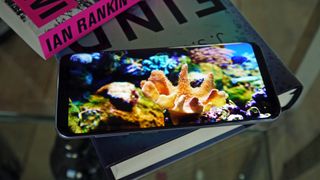
Samsung Galaxy S8 vs Galaxy S8 Plus
The Samsung Galaxy S8 isn't alone, it arrived alongside its bigger brother the Galaxy S8 Plus - but what's the difference between Samsung's two flagship phones?
In truth, not a lot. The Galaxy S8+ boasts a larger 6.2-inch display and 4,000mAh battery, but the rest of the spec sheet is identical to the Galaxy S8.
Check out our versus video below to get the full run-down of the two new Galaxy phones.
- Samsung Galaxy S8 vs Samsung Galaxy S8 Plus
Samsung Galaxy S8 vs Sony Xperia XZ Premium vs iPhone 7
We can't round up our Samsung Galaxy S8 coverage without taking a quick look at how the new smartphone weighs up against the other two most popular handsets on our YouTube channel.
We've put the new Galaxy S8 up against the stylish iPhone 7 and the eye-popping Sony XZ Premium smartphone - check out our video below to see how they compare.
Samsung Galaxy S8 vs LG G6
Both South Korean giants have now launched their 2017 flagship phones, so we've put them head-to-head to find out how they compare - and more importantly, which is best.
Will it be the dual-camera LG G6 or and all-screen Samsung Galaxy S8 - read our in depth versus to find out.
- Samsung Galaxy S8 vs LG G6: which Android phone is better?
Wrap up
In short, we'd urge you to read our Samsung Galaxy S8 hands-on review – it's the place to be if you want a really in-depth look at this phone.
However, if you can't manage to imbibe such a heady brew, then here's the summary…
The Samsung Galaxy S8 is a really, really good-looking phone, with lots of key features that users want – as well as some new additions in the shape of Bixby, although that's not really offering much at the moment.
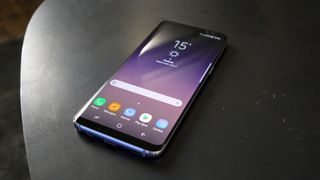
Some will be worried by the fact that the camera and battery haven't been given an obvious boost, and that's something that does need to be checked out when we get the phone in for a full review.
However, this is a phone that's far more impressive than the sum of its parts: while a wrap-around screen doesn't sound like enough to warrant buying a phone, it's an incredibly impressive look, and one that will lure in many buyers.
The camera and battery life are likely to be good enough, and the raw power of this phone will see it shine through nearly every task.
The Galaxy S8 is a great phone at its heart, and we'll now be waiting with much intrigue to see how Apple responds...




No comments:
Post a Comment